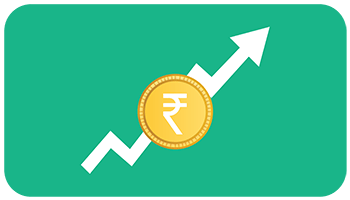The riskometer attempts to give you a complete ‘risk’ picture for the mutual fund scheme. It does this by putting a risk score on every asset class held by the mutual fund scheme. Each debt or equity instrument and other assets, such as cash, gold, and other financial instruments found in mutual fund portfolios, is assigned a particular risk value.
In the case of equities, each position in the portfolio is assigned a risk score based on three main factors:
- Market Capitalization: Small-cap stocks pose more risk than mid-cap stocks, which in turn are riskier than large-cap stocks. The risk value for each is updated every six months.
- Volatility: Stocks with substantial daily price fluctuations are assigned a higher risk value. This is calculated from a stock's price behaviour over the past two years.
- Impact Cost (Liquidity)1: Stocks with low trading volumes experience significant price shifts in large transactions. This raises the impact cost and corresponding risk value. This risk value is based on the three-month average impact cost, including the current month being evaluated.
For debt securities, risk assessment involves the following factors:
- Credit Risk2: The risk value is lower for higher credit ratings (e.g., AAA/G-Sec/SDL/TREPS) and increases for securities with below-investment-grade ratings. This shift happens due to the rising likelihood of default in unrated and below-investment-grade securities.
- Interest-Rate Risk: This risk is determined by using the Macaulay Duration of the portfolio. Bonds with longer maturity period have higher risk values due to their heightened sensitivity to fluctuations in interest rates.
- Liquidity Risk3: Liquidity risk assessment considers factors like listing status, credit rating, and debt instrument structure.
Additionally, SEBI has issued comprehensive guidelines for assigning risk values to other asset classes such as cash & net current assets, derivatives, gold, foreign securities, REITs & InvITs and more.
The total risk score is calculated by averaging each asset's risk value in a mutual fund portfolio.
Lastly, this risk score is used to map the fund scheme to a certain risk level (i.e. Low, Moderately Low, Moderate, Moderately High, or High) on the riskometer .
| Risk Label | Fund’s Average Risk Score |
|---|---|
| Low | 1 |
| Low to Moderate | 2 |
| Moderate | 3 |
| Moderately High | 4 |
| High | 5 |
| Very High | 6 or more |
It is important to note that the riskometer for each mutual fund scheme is evaluated monthly. Mutual Funds/AMCs will display the updated riskometer and portfolio information on their website and the AMFI website within ten days of each month's conclusion.
1. Impact Cost relies on how much the stock price changes when a large purchase or sale occurs.
2. Credit risk indicates the likelihood of a borrower defaulting.
3. Liquidity risk is a bond's ability to be sold before maturity due to market demand.
Disclaimer
Mutual Fund investments are subject to market risks, read all scheme related documents carefully.









